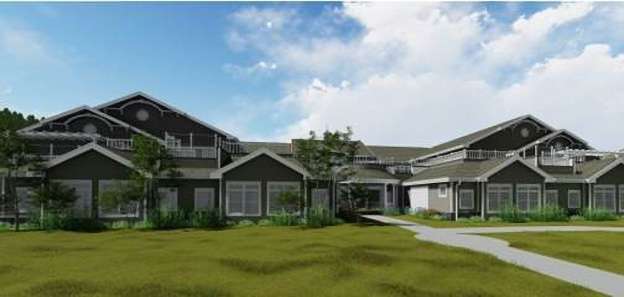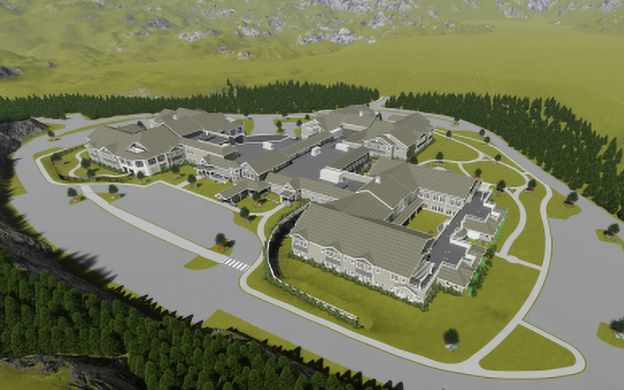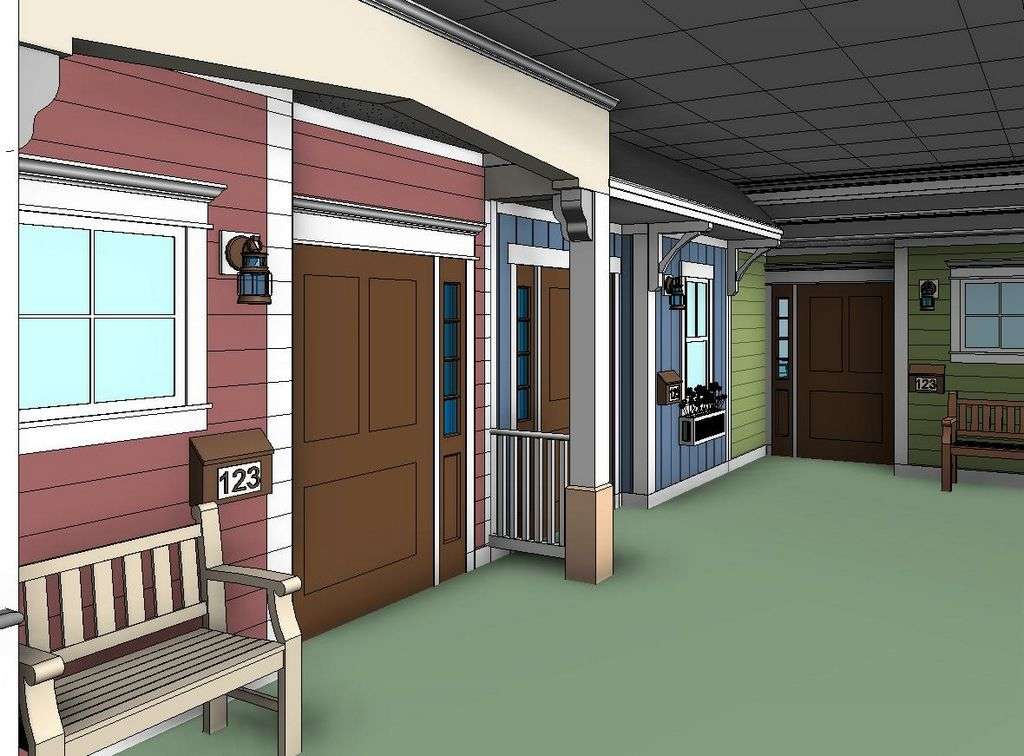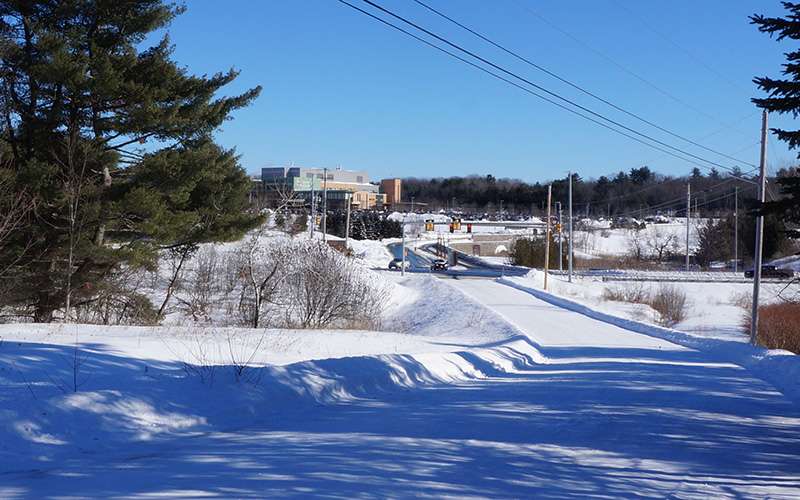
Maine Veterans' Homes $90 million Augusta development to begin
 Courtesy / Maine Veterans' Homes
An aerial rendering of the planned Maine Veterans' Homes long-term care center on Old Belgrade Road in Augusta.
Courtesy / Maine Veterans' Homes
An aerial rendering of the planned Maine Veterans' Homes long-term care center on Old Belgrade Road in Augusta.
AUGUSTA — Construction of a new Maine Veterans’ Homes long-term care center in the northeast end of the city is beginning this month, a plan that’s been five years in the making.
Trees on the 44-acre site across Old Belgrade Road from the MaineGeneral Alfond Center for Health are expected to start coming down next week.
The $90 million, 179,000-square-foot, four-building complex will be completed by early 2021, Maine Veterans’ Homes CEO Kelley Kash said on Tuesday.
Once it’s done, the “small-house”-design complex will be unique among long-term care homes in the state, said Kash.
It will also be another major project in a long undeveloped area of the city that’s poised to become the next development hot spot.
The design of the 138-bed long-term-care residence is built around the overall physical, mental and emotional needs of those who will be using it, said Kash and Deb Fournier, COO of Maine Veterans’ Homes.
“The old traditional way is really built on a hospital model,” Fournier said. Those care centers have long hallways, central nursing stations and semi-private rooms. “They’re meant to mimic what you see in a hospital.”
The new Augusta care center, which replaces a 36-year-old building on Cony Road, is designed to be more like a home, with clusters of private rooms around a living room, dining room, den and kitchen. The four separate two-story buildings are all connected.
Fournier said that studies show that those who live in long-term care centers that are more like a home than a hospital do better physically and mentally. Specific benefits include better sleep, less agitation and a higher level of comfort and self-worth. They’re also less prone to infection and other health issues.
Changes in needs, technology

Maine Veterans’ Homes is an independent nonprofit established by the Legislature in 1977. The Cony Road center, which opened in 1983, was the organization’s first long-term care home. It's headquarters is at 460 Civic Center Drive, close to the planned new care home.
That “hospital-model style” home has aged out, not so much because of the building itself, but because of changes in care and technology.
Kash said that while the life expectancy of a building is usually about 40 years, the technology has changed even faster, and the buildings from the 1980s don’t accommodate the needs of the 21st century.
For instance, he said, “rehabilitation was not a big part of the planning.”
“We’d like to include small house concepts to a degree in all our homes,” Kash said.
The organization has six homes — in Augusta, Scarborough, Bangor, Machias, Caribou and South Paris.
A master plan evaluation in 2014 determined that changes were needed, and would be needed in the decades to come.
“Augusta and Scarborough [which opened in 1990] were our top priorities,” he said.
Augusta was chosen for replacement because of availability of land and the fact it was the the oldest building, he said.
The planning process involved asking residents, staff, families and other stakeholders what they’d like to see in a new care center.
Connectivity and community

They weren’t surprised that private rooms and bathrooms were at the top of the list, Kash and Fournier said.
But an outcome that surprised them was that clients in the secure units felt too restricted, and that those living at the center need to feel connectivity with the community.
The staff also toured centers around the country, gathering ideas.
What resulted are rooms that appear, from the outside, to be part of a village, with different faces. The design helps with both memory care — residents can more easily find their room — and also with comfort levels.
Fournier said they also gathered information from around Maine, and designed the room facades and other elements with an eye toward that region of the state’s architecture and familiar elements.
A University of New England program that places medical students in center as residents for 10 days also helped with feedback. One student who participated was an architect who gave them some design feedback.
“It was kind of happenstance,” Fournier said, but it added some efficiencies to the room design.
Rooms will have small tables, desks, chairs and areas for residents to visit and have privacy and socialize comfortably in their rooms, rather than have visitors stand or sit on the bed, Kash
Aside from more comfortable rooms, the common areas will make it a household. “They’ll participate in daily living activities,” he said.
Each living area will have its own laundry area, and while staff generally do the laundry, “If [residents] want to do their laundry, they can,” he said.
Ground-floor rooms will have patio areas, and outdoor space on the rolling wooded property will include raised beds for gardening and other outdoor activities.
After input from those participating in research, they also added a pond that will be stocked for fishing.
The fourth building will include those things that are necessary now that weren’t thought of when the Augusta center was built in 1983, including a larger rehab pool, a gym and more extensive multi-purpose room.
But it will also have a “village center,” with “shops” that offer coffee, ice cream and gelato, beauty salon and barber services, small market and a business center that looks like a bank.
While the number of veterans in general is decreasing, the number of senior veterans who need long-term care is not.
Team design, building approach

The search for ideas also included a search for architects and builders familiar with the small house design concept, Kash said.
The result is a team of architects, including Gawron Turgeon Architects, of Scarborough, and Plunkett Raysich Architects, of Wisconsin.
The building team is Cianbro, of Pittsfield, and VJS Construction Services of Milwaukee, Wisc.
Kash said the individual cottage front design by the Wisconsin builders and architects was one of the many selling points.
The $90 million price tag for the project is up from the $76 million estimate when the project was approved by the Augusta Planning Board in early 2017.
“The cost escalation has been enormous [over the past two years],” Kash said.
A U.S. Department of Veterans Affairs State Home construction grant of $50 million will help pay for the project.
While Maine Veterans’ Homes would love to do the same type of project for all the locations in the future, in the present the other locations are doing what they can, Kash and Fournier said.
In Scarborough, the dining area has been reconfigured to be restaurant-style.
In Bangor, a $4.5 million renovation underway is reconfiguring common areas in the 20,000-square-foot building to add some of the comfort aspects the new Augusta center will have, and also adding 5,000 square feet of space. A $2.7 million federal VA grant helped support that project.
'Service center within a service center'

One of the attractions of the location in the largely undeveloped northeast area of Augusta is proximity to the MaineGeneral hospital, which opened in 2013, Kash said.
The new development, on side road Henry's Way, will share a traffic light with the hospital.
Adjacent to the hospital is the Alfond Center for Cancer Care, which opened in 2013.
Along with the hospital and cancer care center came a new Interstate 95 exit — Exit 113 — that opened that end of the city up to more development.
The city also established a medical development zone in the area around the hospital, meant to attract development like the long-term care home.
The area around Exits 112A and B, which is a mile from the new Maine Veterans Home site, includes the Augusta Civic Center and the large Marketplace of Augusta shopping area.
The pastoral Maine Veterans Memorial Cemetery separates the two areas.
The National Guard opened a 101,000-square-foot joint headquarters next to the cemetery earlier this year.
A 250-unit apartment complex is planned for 15 acres on Civic Center Drive, also near the new Maine Veterans’ Homes development.
Much of the open land in that section of Augusta, which only started development in the past 20 years, now has signs from a variety of real estate brokers.
“North Augusta is clearly ripe for continued development,” said Keith Luke, Augusta’s deputy director of economic development. “MaineGeneral, the Alfond Cancer Center, Maine Veterans’ Home combined with a recently approved 250-unit rental housing project will all concentrate activity in and around Exit 112 and 113 for years to come.”
He said, “In many respects, North Augusta has become a “service center within a service center.”
Unique population
Fournier and Kash say the needs of Maine Veterans’ Homes clients are unique in some ways.
While the majority of the population in long-term care is female, the majority in Maine Veterans’ Homes six locations, which is 86% veterans, is male. The organization also provides services to spouses of veterans and parents who have lost a child in combat.
That means design also took into account larger occupants, as well as a focus on things that may calm anxiety and symptoms of PTSD.
Kash, who is a retired U.S. Air Force colonel, said there is a camaraderie among the residents of the homes, borne of shared experience.
That extends to the extensive network of volunteers the homes have, many of them veterans.
“We have volunteers who are there every day,” he said, and the variety of activities and services provided by volunteers are a huge benefit to the homes.
Two of the centers — Machias in 2018 and Scarborough in 2016 — were awarded the American Health Care Association Quality Gold Award. Only 38 nursing homes nationwide have won the award since it was first given out in 2004, and the two centers are the only Maine Gold winners.
While both the Augusta and Bangor projects benefited from U.S. Department of Veterans Affairs State Home construction grants, Maine Veterans’ Homes is not part of the federal department, but an independent nonprofit.
That means funding is similar to that of other nonprofit long-term care organizations — Medicaid, Medicare, grants, donations and other sources.
Kash said the federal grant for the Augusta project will pay about three-fifths of the estimated $90 million cot, but a capital campaign will launch soon.
The organization plans to break ground next month, with a formal groundbreaking April 18.










Comments